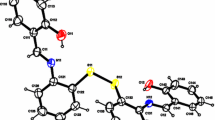Abstract
Highly reactive OH radicals, formed in an iron-ion catalyzed Fenton reaction, are implicated in many pathological conditions. The quest for Fenton reaction inhibitors, either radical scavenger or metal-ion chelator antioxidants, spans the previous decades. Purine nucleotides were previously studied as natural modulators of the Fenton reaction; however, the modulatory role of purine nucleotides remained in dispute. Here, we have resolved this long-standing dispute and demonstrated a concentration-dependent biphasic modulation of the Fenton reaction by nucleotides. By electron spin resonance measurements with 0.1 mM Fe(II), we observed an increase of •OH production at low purine nucleotide concentrations (up to 0.15 mM), while at higher nucleotide concentrations, an exponential decay of •OH concentration was observed. We found that the phosphate moiety, not the nucleoside, determines the pro/antioxidant properties of a nucleotide, suggesting a chelation-based modulation. Furthermore, the biphasic modulation mode is probably due to diverse nucleotide–Fe(II) complexes formed in a concentration-dependent manner. At ATP concentrations much greater than Fe(II) concentrations, multiligand chelates are formed which inhibit the Fenton reaction owing to a full Fe(II) coordination sphere. In addition to natural nucleotides, we investigated a series of base- or phosphate-modified nucleotides, dinucleotides, and inorganic phosphates, as potential biocompatible antioxidants. Ap5A, inorganic thiophosphate and ATP-γ-S proved highly potent antioxidants with IC50 values of 40, 30, and 10 μM, respectively. ATP-γ-S proved 100 and 20 times more active than ATP and the potent antioxidant Trolox, respectively. In the presence of 30 μM ATP-γ-S no •OH was detected after 5 min in the Fenton reaction mixture. The most potent antioxidants identified inhibit the Fenton reaction by forming full coordination sphere chelates.











Similar content being viewed by others
References
Marks DB, Marks AD, Smith CM (1996) Basic medical biochemistry: a clinical approach. Lippincott Williams & Wilkins, Philadelphia
Korycka D, Malgorzata B, Richardson T (1978) Crit Rev Food Sci Nutr 10:209–241
Packer L, Valenza M, Serbinova E, Starkereed P, Frost K, Kagan V (1991) Arch Biochem Biophys 288:533–537
Bergman M, Perelman A, Dubinsky Z, Grossman S (2003) Phytochemistry 62:753–762
Levites Y, Weinreb O, Maor G, Youdim MB, Mandel S (2001) J Neurochem 78:1073–1082
Galey JB (2001) Mini Rev Med Chem 1:233–242
Faa G, Crisponi G (1999) Coor Chem Rev 184:291–310
Ben-Shachar D, Eshel G, Finberg JPM, Youdim MBH (1991) J Neurochem 56:1441–1444
Heinz U, Hegetschweiler K, Acklin P, Faller B, Lattmann R, Schnebli HP (1999) Angew Chem Int Ed Engl 38:2568–2570
Zheng H, Weiner LM, Bar-Am O, Epsztejn S, Cabantchik ZI, Warshawsky A, Youdim MBH, Fridkin M (2005) Bioorg Med Chem 13:773–783
Tadolini B (1988) Free Radical Res Commun 5:237–243
Kachur AV, Manevich Y, Biaglow JE (1997) Free Radical Res 26:399–408
Biaglow JE, Held KD, Manevich Y, Tuttle S, Kachur A, Uckun F (1996) Radical Res 145:554–562
Floyd RA (1983) Arch Biochem Biophys 225:263–270
Floyd RA, Lewis CA (1983) Biochemistry 22:2645–2649
Gutteridge JM, Nagy I, Maidt L, Floyd RA (1990) Arch Biochem Biophys 277:422–428
Swennen ELR, Dagnelie PC, Bast A (2006) Free Radical Res 40:53–58
Hillaire-Buys D, Shahar L, Fischer B, Chulkin A, Linck N, Chapal J, Loubatieres-Mariani MM, Petit P (2001) Drug Dev Res 53:33–43
Halbfinger E, Major DT, Ritzmann M, Ubl J, Reiser G, Boyer JL, Harden KT, Fischer B (1999) J Med Chem 42:5325–5337
Holmes RE, Robins RK (1965) J Am Chem Soc 87:1772–1776
Shaver SR, Rideout JL, Pendergast W, Douglass JG, Brown EG, Boyer JL, Patel RI, Redick CC, Jones AC, Picher M, Yerxa BR (2005) Purinergic Signal 1:183–191
Kremer ML (2003) J Phys Chem 107:1734–1741
Welch KD, Davis TZ, Aust SD (2002) Arch Biochem Biophys 397:360–369
Winston GW, Harvey W, Berl L, Cederbaum AI (1983) Biochem J 216:415–421
Gutteridge JMC (1984) Biochem J 224:761–767
Richter Y, Fischer B (2003) Nucleosides Nucleotides Nucleic Acids 22:1757–1780
Thomas MJ, Bielski BHJ (1989) J Am Chem Soc 111:3315–3319
Panganamala RV, Miller JS, Gwebu ET, Sharma HM, Cornwell DG (1977) Prostaglandins 14:261–271
Riddles PW, Blakeley RL, Zerner B (1979) Anal Chem 94:75–81
Ellman GL (1958) Arch Biochem Biophys 74:443–450
Yokoi I, Toma J, Liu JK, Kabuto H, Mori A (1995) Free Radical Biol Med 19:473–479
Kachur AV, Tuttle SW, Biaglow JE (1998) Radiat Res 150:475–482
Sigel H (1987) Eur J Biochem 165:65–72
Sigel H (1993) Chem Soc Rev 22:255–267
Graf E, Mahoney JR, Bryant RG, Eaton JW (1984) J Biol Chem 259:3620–3624
Rush JD, Maskos Z, Koppenol WH (1990) FEBS Lett 261:121–123
Neuhard J, Nygaard P (1987) Escherichia coli and Salmonella typhimurium: cellular and molecular biology. American Society for Microbiology, Washington
Boveris A (1977) Adv Exp Med Biol 78:67–82
Boveris A, Chance B (1973) Biochem J 134:707–716
Boveris A, Cadenas E (1982) Production of superoxide radicals and hydrogen peroxide in mitochondria. In: Oberley L (ed) Superoxide dismutase, vol II. CRC, Boca Raton, pp 15–30
Lippard SJ, Berg JM. (1994) Principles of bioinorganic chemistry. University Science Books, Mill Valley
Author information
Authors and Affiliations
Corresponding author
Additional information
Patent pending.
Rights and permissions
About this article
Cite this article
Richter, Y., Fischer, B. Nucleotides and inorganic phosphates as potential antioxidants. J Biol Inorg Chem 11, 1063–1074 (2006). https://doi.org/10.1007/s00775-006-0143-4
Received:
Accepted:
Published:
Issue Date:
DOI: https://doi.org/10.1007/s00775-006-0143-4




